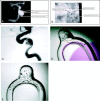Management of neuroform stent dislodgement and misplacement
- PMID: 14561609
- PMCID: PMC7976300
Management of neuroform stent dislodgement and misplacement
Abstract
A self-expanding stent has recently been introduced for the treatment of wide-neck aneurysms. We describe two cases of stent malposition within large aneurysms. In the first case, the stent was dislodged during microcatheterization. This was managed by placement of a second stent through the interstices of the first followed by aneurysm coiling. In the second case, after deployment, the proximal portion of the stent moved into the aneurysm as the exchange guidewire was removed. This patient was treated by vessel sacrifice.
Figures


References
-
- Molyneux A, Kerr R, Stratton I, et al. International Subarachnoid Aneurysm Trial (ISAT) of neurosurgical clipping versus endovascular coiling in 2143 patients with ruptured intracranial aneurysms: a randomised trial. Lancet 2002;360:1267–1274 - PubMed
-
- Cognard C, Weill A, Spelle L, et al. Long-term angiographic follow-up of 169 intracranial berry aneurysms occluded with detachable coils. Radiology 1999;212:348–356 - PubMed
-
- Murayama Y, Nien YL, Duckwiler G, et al. Guglielmi detachable coil embolization of cerebral aneurysms: 11 years’ experience. J Neurosurg 2003;98:959–966 - PubMed
-
- Moret J, Cognard C, Weill A, et al. Reconstruction technique in the treatment of wide-neck intracranial aneurysms. Long-term angiographic and clinical results Apropos of 56 cases [in French]. J Neuroradiol 1997;24:30–44 - PubMed
-
- Lanzino G, Wakhloo AK, Fessler RD, et al. Efficacy and current limitations of intravascular stents for intracranial internal carotid, vertebral, and basilar artery aneurysms. J Neurosurg 1999;91:538–546 - PubMed
Publication types
MeSH terms
LinkOut - more resources
Full Text Sources
Medical
